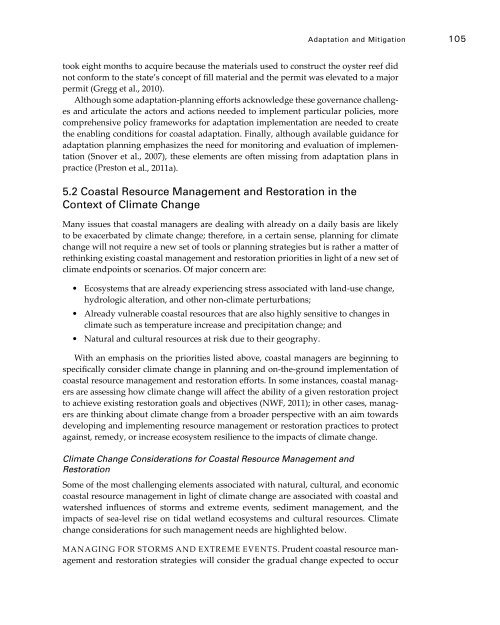Coastal Impacts, Adaptation, and Vulnerabilities - Climate ...
Coastal Impacts, Adaptation, and Vulnerabilities - Climate ...
Coastal Impacts, Adaptation, and Vulnerabilities - Climate ...
Create successful ePaper yourself
Turn your PDF publications into a flip-book with our unique Google optimized e-Paper software.
<strong>Adaptation</strong> <strong>and</strong> Mitigation 105took eight months to acquire because the materials used to construct the oyster reef didnot conform to the state’s concept of fill material <strong>and</strong> the permit was elevated to a majorpermit (Gregg et al., 2010).Although some adaptation-planning efforts acknowledge these governance challenges<strong>and</strong> articulate the actors <strong>and</strong> actions needed to implement particular policies, morecomprehensive policy frameworks for adaptation implementation are needed to createthe enabling conditions for coastal adaptation. Finally, although available guidance foradaptation planning emphasizes the need for monitoring <strong>and</strong> evaluation of implementation(Snover et al., 2007), these elements are often missing from adaptation plans inpractice (Preston et al., 2011a).5.2 <strong>Coastal</strong> Resource Management <strong>and</strong> Restoration in theContext of <strong>Climate</strong> ChangeMany issues that coastal managers are dealing with already on a daily basis are likelyto be exacerbated by climate change; therefore, in a certain sense, planning for climatechange will not require a new set of tools or planning strategies but is rather a matter ofrethinking existing coastal management <strong>and</strong> restoration priorities in light of a new set ofclimate endpoints or scenarios. Of major concern are:• Ecosystems that are already experiencing stress associated with l<strong>and</strong>-use change,hydrologic alteration, <strong>and</strong> other non-climate perturbations;• Already vulnerable coastal resources that are also highly sensitive to changes inclimate such as temperature increase <strong>and</strong> precipitation change; <strong>and</strong>• Natural <strong>and</strong> cultural resources at risk due to their geography.With an emphasis on the priorities listed above, coastal managers are beginning tospecifically consider climate change in planning <strong>and</strong> on-the-ground implementation ofcoastal resource management <strong>and</strong> restoration efforts. In some instances, coastal managersare assessing how climate change will affect the ability of a given restoration projectto achieve existing restoration goals <strong>and</strong> objectives (NWF, 2011); in other cases, managersare thinking about climate change from a broader perspective with an aim towardsdeveloping <strong>and</strong> implementing resource management or restoration practices to protectagainst, remedy, or increase ecosystem resilience to the impacts of climate change.<strong>Climate</strong> Change Considerations for <strong>Coastal</strong> Resource Management <strong>and</strong>RestorationSome of the most challenging elements associated with natural, cultural, <strong>and</strong> economiccoastal resource management in light of climate change are associated with coastal <strong>and</strong>watershed influences of storms <strong>and</strong> extreme events, sediment management, <strong>and</strong> theimpacts of sea-level rise on tidal wetl<strong>and</strong> ecosystems <strong>and</strong> cultural resources. <strong>Climate</strong>change considerations for such management needs are highlighted below.Managing for STORMS <strong>and</strong> EXTREME EVENTS. Prudent coastal resource management<strong>and</strong> restoration strategies will consider the gradual change expected to occur
















